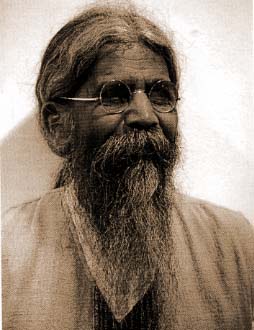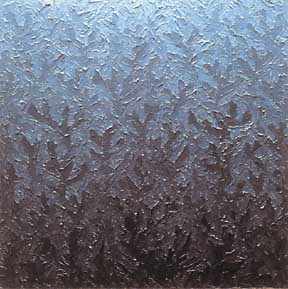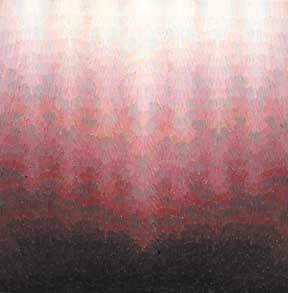 |
Sumatimohan |
Current Issue Highlights More Readings DA Home About Direct Art
SUMATIMOHAN - New Age Mystic, a Guru in Greenwich Village
by Alaiyo Bradshaw
The Chai (spiced tea) aroma pervades the small kitchen in the tiny three-room apartment at 81 MacDougal Street. Sumatimohan, the artist, is suffused with the joy of sharing his life’s philosophy. Before a guest can begin a business transaction, one must first enjoy the comfort of a home-cooked, vegetarian Indian meal and finish off with the strong fragrant ginger tea. A visit with Sumatimohan is a spiritual experience complete with music and a clear view of his subjective abstractions on the small, cramped walls.
 |
Sumatimohan |
Sumatimohan was born in the village of Ghodiyal, near Palanpur, in Gujarat, India. Ghodiyal, now populated with 5,000 people, then had about 500 -1000 residents. It was a completely natural, organic village without electricity, telephones or clocks. Only one man in the village had a clock. When a baby was born, the family went to his shop to note the time of birth. Local farms provided the vegetarian village with food. Food consisted of beans, rice, bread, dried vegetables and fresh vegetables. There were artisans producing everything from gold to shoes, and even barbers — all the basic needs were met. The only trade not found in the village was weaving, so the neighboring villages provided clothing. The water was hand drawn from wells.
He lived in Ghodiyal for ten years where he attended school through the 2nd grade. At this early age, he decided to take the art path. His education went far beyond the expectations of the small village. Because there were no government schools there, so he had to leave in order to study further. He joined his sister’s family in Gola, then Palanpur, neighboring villages, to finish his schooling through high school. He was the first to attend high school in the big neighboring town. He received a government diploma in art and finished his Fine Arts Master’s degree through the State Higher Art Examination in Bombay.
A one-year teacher’s training program in drawing enabled him to teach high school art. His dream was to go to Paris, but when his son died of an illness, the dream died as well. After showing his works all over India, he decided to come to the art center of the time, New York City, where he received his Masters of Fine Arts from Pratt Institute in 1973. Certainly, he was the first from his village to venture to the United States. He had friends residing there and the English he learned as a second language made this transition easier.
Sumatimohan had an arranged marriage at the age of sixteen and raised three children with his ex-wife. The kids were born in his home village in the same room in which he came into the world. This is traditional, as were the housing arrangements. Newly married couples move into the husband’s family’s house. His wife spent some time with her own family while he was away at school. When he came home on vacation, his family would bring her back to be with him. One of Sumatimohan’s favorite people from his home village was the Yogi, or priest. He took care of the temple and visited the sick with healing prayers. He had long hair and a beard, looking very much like the artist himself.
 |
Raj-Lok #14 Oil on canvas, 22" x 22", 1978 |
His deeply spiritual work stems from his Jainism beliefs. As he says,"All living beings are equal; they share the spirit." Sumatimohan speaks in a melodic heavy accent and constantly strokes his long graying beard. He wears his hair long. There is cosmic energy in long hair. "Hair is an antenna," he says. If he has to cut his hair, he does not feel well for a few days.
Jainism was established in 500 BC, during the time of the Buddha. The spiritual leader at that time was called Nataputta Mahavira or Jina. He was the 24th leader. Based on a doctrine of non-violence, the Jains believe that violence comes from holding more, materially, than we need. This simple concept that guides the Jains is called indirect violence. There is no specific god in Jainism, but instead a universal energy serves as God. Karma, the belief that what we put into life, positive or negative, comes back to us in the future, is also held. The final goal of Jainism is Nirvana, an enlightened state of being that puts an end to the cycle of reincarnation: no more death and no more birth. There are also commandments to follow: do not steal, do not take more than one partner, and do not take more than you need. Everything should be done in moderation. Some of the monks live with nothing, not even clothing. The community takes care of them. All Jains are vegetarians, and their trades are mainly in business. Ninety percent of the Jains are in India, and they total 3.7 million nationally.
Sumatimohan dedicates the hours of his days to certain tasks, which take place from 12pm to 12am. At 11:00 he gets dressed after a morning of music on the flute or harmonium he brought over from India and meditation in front of a series of white on white paintings done by the artist in the ‘80s. The 24 square panels in the series cover the walls of the small room in the back of the kitchen and remind one of a Japanese interior, sliding door. Sumatimohan drinks the magical tea, which no one makes like the man himself, three times a day. He gave up smoking 20 years ago and drinks no alcohol.
Rothko and Matisse, who were brought to his attention after his arrival in the States, inspire his work. His work travels from bottom to top, dark to light, earth to spirit-bound — "The light of God." The idea of non-representation can be explained. There is more than what meets the eye. In the oil works, which are made of ground pigments and linseed oil, there are often people marching towards the light. The watercolors have the feel of the ocean blowing up in a quiet turmoil and recall Turner. Helen Frankenthaler and her stained color field paintings also come to mind.
 |
Unknown #26 Oil on canvas 24" x 24", 1974 |
It is hard to imagine the humble, cramped home he has resided in for the last twenty-three years as the place in which his three children were raised. With his ex-wife, he ran a business from 1974 to 1984 called "Champakali Boutique," which sold natural cotton clothing, located down the block from his apartment. Part of his family has returned to India; the others live in Chinatown. He has been visited by friends and diplomats alike. The consul general of Paraguay chose a painting and stayed for spiced tea. Others, such as the ambassador of Monaco and diplomats from Trinidad, came to pick up special paintings from the generous artist. The Ambassador of Kyrgyzstan gave him the national hat, a Kalpat.
He is now alone, content and waiting to make his mission come to fruition. His mission is to give away one painting to every country in the world as an act of universal generosity. He has written to the prime ministers and presidents to offer each a painting. His hope is that the work would be hung in the national museum of each country. Out of over two hundred requests made by Sumatimohan, nine representatives from interested countries picked up the paintings in person. In the ‘80s he donated work to twenty-three countries, mainly in Asia and Africa. Many countries politely refused him, including the United States. He offers the representatives that accept a choice of imagery, usually oil and square in format. Then a receipt is signed and stamped with the country’s official seal. The paintings are never to be sold.
His mission continued on in a different fashion. After the low success rate of his first offer in 1993, he made a second offer. In addition to the painting, he would donate his services as a professor of art for up to a year. The government of said country would have to pay for food, shelter and transportation. So far, countries have either refused him or stated lack of funds. The artist’s mission is also dedicated in the names of his children.
Since 1973, Sumatimohan has been in numerous shows in New York galleries, including Vorpal Gallery, National Arts Club, Tradition Three Thousand and Lorence Monk Gallery. His most recent works are ink on paper dealing with transitional self-portraits. His paintings are in museums, private collections and public spaces. In January of this year, he was featured in a retrospective by Nature-Morte Gallery at the Academy of Fine Arts and Literature in New Delhi.
Now his single mission is to go back to India and build a spiritual artists community. Will this dream come true for the humble guru who now is a mixture of all of his life’s experiences? Or will he create another venture of international goodwill? We hope he makes it back to India, to his beginnings, to bring back his learned experiences and to broaden the horizons of his small village — the home he longs for and has never forgotten.
More readings - Truth Gives Life to Art by Sumatimohan
Current Issue Highlights More Readings DA Home About Direct Art